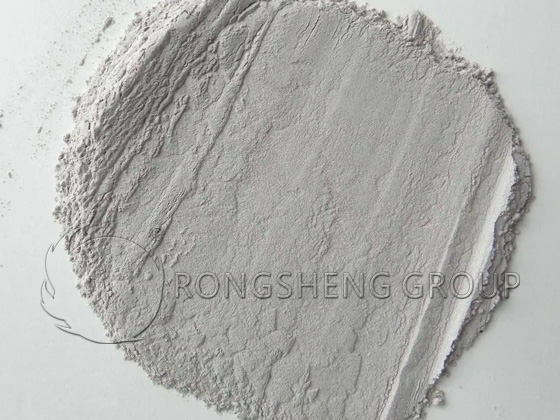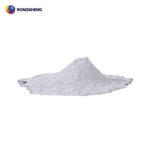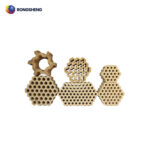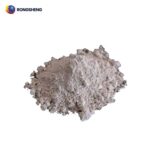Preparation of High-Purity Dense Zircon Powder and Its Application Advantages
Neodymium-doped phosphate laser glass features high energy storage, high gain, low nonlinear coefficients, and a high damage threshold. It is widely used as the amplifier working material for large laser-driven inertial confinement fusion (ICF) devices. To achieve high gain, in addition to requiring the neodymium glass to have a large stimulated light emission cross-section and a high number of inverted ions, the content of impurity ions must be minimized to reduce the absorption coefficient at the laser wavelength. Studies have shown that transition metal impurities such as Fe and Cu have a significant impact on the optical absorption loss of neodymium glass at a laser wavelength of 1053 nm. Even impurity levels as low as μg/g can lead to significant absorption losses, necessitating strict control of Fe and Cu ion contamination during the production process. During neodymium glass production, high-temperature molten glass comes into prolonged contact with large areas of refractory materials, making it very easy for impurities from the refractory materials to be introduced into the glass due to corrosion.
Zircon Refractory Materials
Zircon refractory materials feature high thermal decomposition temperatures, low thermal expansion coefficients, excellent chemical stability, and resistance to high-temperature melt erosion. They are widely used as lining or base brick materials in furnaces for alkali-free glass balls, glass fibers, and optical glass. Furthermore, because both ZrO2 and SiO2 are acidic, zircon refractory materials are more acidic, resulting in superior erosion resistance in phosphate-based glass. Therefore, zircon refractory materials are an ideal choice for continuous melting tank furnaces for phosphate-based laser neodymium glass.
Commonly used dense zircon bricks are made by grinding natural zircon ore into a fine powder and then sintering at high temperatures. Zircon refractory materials produced using this traditional process have high impurity contents such as iron and copper, making them unsuitable for the production of laser neodymium glass. This paper uses a high-temperature solid-phase method to synthesize high-purity zircon raw materials and sinter them at temperatures exceeding 1550°C to produce the high-purity dense zircon bricks required for the experiment. Solid-phase synthesis process parameters and properties of high-purity dense zircon and its effect on reducing light absorption loss in laser glass.

Synthesis and Preparation of High-Purity Zircon Powder and Bulk Materials
High-purity ZrO2 and SiO2, both domestically produced with a purity exceeding 99.9% (mass fraction), were used as the primary raw materials. The content of transition metal elements, such as Fe and Cu, was less than 10 μg/g. It should be noted that due to the similar properties of zirconium (Zr) and hafnium (Hf), it is difficult to fully distinguish between them. XRF semi-quantitative analysis revealed that both the ZrO2 raw material and the standard zircon sample contained 1% to 2% (mass fraction) of HfO2. For ease of presentation, ZrO2 content here and below refers to the total content of ZrO2 + HfO2.
The raw materials were weighed to a ratio of 67.22% ZrO2, 32.78% SiO2, and 0.3% to 2% TiO2 (all mass fractions). After 24 hours of ball milling in a zirconia ball mill, a mixed raw material with a particle size of less than 50 μm was obtained. Zircon powder was synthesized from the ball-milled raw material at different temperatures ranging from 1350°C to 1500°C, with each temperature held for 24 h (1T) and 48 h (2T). The resulting samples were labeled 1T 350-1T 500 and 2T 350-2T 500, respectively. After holding at 1500°C for 48 h, the resulting high-purity zircon raw material (2T 500) was ball-milled, cold isostatically pressed, and sintered at 1550°C to form the high-purity, dense zircon sample (HPDZS) required for the experiment.
Application Advantages of High-Purity Dense Zircon Powder
A raw material powder with a zircon phase content of approximately 95.77% was synthesized using high-purity oxides ZrO2 and SiO2 held at 1500°C for 48 hours. After ball milling and cold isostatic pressing, it was sintered at 1550°C for 48 hours. High-purity dense zircon with a pure zircon phase structure was successfully synthesized. The apparent porosity, density, impurity content, micromorphology, and high-temperature corrosion resistance of the resulting material were investigated. The results showed that the transition metal impurity content of the high-purity dense zircon was much lower than that of ordinary dense zircon. In particular, the impurity Fe content was only 29 μg/g, and the Cu content was less than 1 μg/g, which is only 1/10 of that of ordinary zircon. Compared to ordinary zircon, the synthesized high-purity zircon exhibits a more dense and uniform micromorphology, with pores primarily distributed within the grains.
Although the apparent porosity of synthetic high-purity zircon is slightly higher than that of conventional zircon, the high-temperature erosion resistance of high-purity dense zircon is comparable to or even slightly better than that of conventional dense zircon. Measurements of optical absorption loss in glass prepared under dynamic erosion conditions show that the increase in glass loss caused by synthetic high-purity dense zircon samples is only approximately 0.06%·cm⁻¹, one-third the increase in loss caused by conventional dense zircon samples. The use of synthetic high-purity dense zircon can help reduce the optical absorption coefficient of laser glass and improve its laser gain performance.





